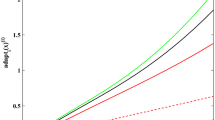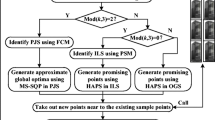Abstract
Multi-fidelity surrogate models received a lot of attention in engineering optimization due to their ability to achieve the required accuracy at a lower cost. However, selecting an appropriate scale factor to improve the prediction accuracy remains a challenge. As a result, this paper proposes a novel method for determining the scale factor. Unlike previous studies, the proposed method uses feasible intervals to determine a series of scaling factors and corresponding multi-fidelity surrogate models. Then, the ensemble of multi-fidelity surrogate models is used to improve prediction accuracy. Twenty test functions and an engineering problem are used to validate the proposed model. The results show that this model outperforms the other multi-fidelity surrogate models in terms of prediction accuracy and robustness. Furthermore, the impact of various cost ratios and proportions on the performance of the proposed model is investigated. Once again, it demonstrates a higher priority than the other models. This work provides a new approach to the design and optimization of engineering problems.














Similar content being viewed by others
References
Absi GN, Mahadevan S (2019) Simulation and sensor optimization for multifidelity dynamics model calibration. AIAA J 58(2):879–888
Assari P, Dehghan M (2017) The numerical solution of two-dimensional logarithmic integral equations on normal domains using radial basis functions with polynomial precision. Eng Comput 33(4):853–870
Basheer IA, Hajmeer M (2000) Artificial neural networks: fundamentals, computing, design, and application. J Microbiol Methods 43(1):3–31
Berci M, Toropov VV, Hewson RW, Gaskell PH (2014) Multidisciplinary multifidelity optimisation of a flexible wing aerofoil with reference to a small UAV. Struct Multidisc Optim 50(4):683–699
Bhattacharjee KS, Singh HK, Ray T (2018) Multiple surrogate-assisted many-objective optimization for computationally expensive engineering design. J Mech Des 140(5):051403
Bouhlel MA, Martins JRRA (2019) Gradient-enhanced kriging for high-dimensional problems. Eng Comput 35(1):157–173
Choi W, Radhakrishnan K, Kim NH, Park JS (2021) Multi-fidelity surrogate models for predicting averaged heat transfer coefficients on endwall of turbine blades. Energies 14(2):482
Clarke SM, Griebsch JH, Simpson TW (2005) Analysis of support vector regression for approximation of complex engineering analyses. J Mech Des 127(6):1077–1087
Dammak K, Hami AEI (2020) Multi-objective reliability based design optimization using Kriging surrogate model for cementless hip prosthesis. Comput Methods Biomech Biomed Engin 23(12):854–867
Durantin C, Rouxel J, Désidéri JA, Glière A (2017) Multifidelity surrogate modeling based on radial basis functions. Struct Multidisc Optim 56(5):1061–1075
Fernández-Godino MG, Park C, Kim NH, Haftka, RT (2016) Review of multi-fidelity models. arXiv preprint arXiv: 1609.07196
Fernández-Godino MG, Park C, Kim NH (2019) Issues in deciding whether to use multifidelity surrogates. AIAA J 57(5):2039–2054
Feng Y, Chen Z, Dai Y, Wang F, Cai J, Shen Z (2018) Multidisciplinary optimization of an offshore aquaculture vessel hull form based on the support vector regression surrogate model. Ocean Eng 166:145–158
Forrester AI, Sóbester A, Keane AJ (2007) Multi-fidelity optimization via surrogate modelling. Proc R Soc A 463(2088):3251–3269
Gano SE, Renaud JE, Martin JD, Simpson TW (2006) Update strategies for kriging models used in variable fidelity optimization. Struct Multidisc Optim 32(4):287–298
Haftka RT (1991) Combining global and local approximations. AIAA J 29(9):1523–1525
Hutchison MG, Unger ER, Mason WH, Grossman B, Haftka RT (1994) Variable-complexity aerodynamic optimization of a high-speed civil transport wing. J Aircr 31(1):110–116
Jin R, Chen W, Simpson TW (2001) Comparative studies of metamodeling techniques under multiple modelling criteria. Struct Multidisc Optim 23(1):1–13
Kaminsky AL, Wang Y, Pant K (2021) An efficient batch K-fold cross-validation voronoi adaptive sampling technique for global surrogate modeling. J Mech Des 143(1):011706
Li K, Liu Y, Wang S, Song XG (2021) Multifidelity data fusion based on gradient-enhanced surrogate modeling method. J Mech Des 143(12):121704
Liu Y, Collette M (2014) Improving surrogate-assisted variable fidelity multi-objective optimization using a clustering algorithm. Appl Soft Comput 24:482–493
Park C, Haftka RT, Kim NH (2018) Low-fidelity scale factor improves Bayesian multi-fidelity prediction by reducing bumpiness of discrepancy function. Struct Multidisc Optim 58(2):399–414
Peherstorfer B, Willcox K, Gunzburger M (2018) Survey of multifidelity methods in uncertainty propagation, inference, and optimization. SIAM Rev 60(3):550–591
Qian J, Yi J, Cheng Y, Zhou Q (2020) A sequential constraints updating approach for Kriging surrogate model-assisted engineering optimization design problem. Eng Comput 36(3):993–1009
Rafiee V, Faiz J (2019) Robust design of an outer rotor permanent magnet motor through six-sigma methodology using response surface surrogate model. IEEE Trans Magn 55(10):1–10
Rashki M, Azarkish H, Rostamian M, Bahrpeyma A (2019) Classification correction of polynomial response surface methods for accurate reliability estimation. Struct Saf 81:101869
Shi R, Long T, Baoyin H, Ye N, Wei Z (2021) Adaptive kriging-assisted optimization of low-thrust many-revolution transfers to geostationary Earth orbit. Eng Optim 53(12):2040–2055
Shu LS, Jiang P, Song XG, Zhou Q (2019) Novel approach for selecting low-fidelity scale factor in multifidelity metamodeling. AIAA J 57(12):5320–5330
Song XG, Lv L, Sun W, Zhang J (2019) A radial basis function-based multi-fidelity surrogate model: exploring correlation between high-fidelity and low-fidelity models. Struct Multidisc Optim 60(3):965–981
Wang B (2015) A local meshless method based on moving least squares and local radial basis functions. Eng Anal Boundary Elem 50:395–401
Wang GG, Shan S (2007) Review of metamodeling techniques in support of engineering design optimization. J Mech Des 129(4):370–380
Wang S, Liu Y, Zhou Q, Lv LY, Song XG (2021) A multi-fidelity surrogate model based on moving least squares: fusing different fidelity data for engineering design. Struct Multidisc Optim 64(6):3637–3652
Xing J, Luo Y, Gao Z (2020) A global optimization strategy based on the Kriging surrogate model and parallel computing. Struct Multidisc Optim 62(1):405–417
Zhang L, Wu Y, Jiang P, Choi SK, Zhou Q (2022) A multi-fidelity surrogate modeling approach for incorporating multiple non-hierarchical low-fidelity data. Adv Eng Inform 51:101430
Zhang X, Xie F, Ji T, Zhu Z, Zheng Y (2021) Multi-fidelity deep neural network surrogate model for aerodynamic shape optimization. Comput Methods Appl Mech Eng 373:113485
Zhang Y, Kim NH, Park C, Haftka RT (2018) Multifidelity surrogate based on single linear regression. AIAA J 56(12):4944–4952
Zhou Q, Shao X, Jiang P, Zhou H, Shu L (2015) An adaptive global variable fidelity metamodeling strategy using a support vector regression based scaling function. Simul Model Pract Theory 59:18–35
Funding
This research is funded by the National Key Research and Development Program of China (No. 2018YFB1700704) and the National Natural Science Foundation of China (No. 52075068).
Author information
Authors and Affiliations
Corresponding author
Ethics declarations
Conflict of interest
The authors declare that they have no conflict of interest.
Replication of results
The results provided in this paper are generated by MATLAB codes developed by the authors. The codes can be available upon request by contacting the corresponding author via email.
Additional information
Responsible Editor: Erdem Acar
Publisher's Note
Springer Nature remains neutral with regard to jurisdictional claims in published maps and institutional affiliations.
Appendix
Rights and permissions
About this article
Cite this article
Zhang, S., Liang, P., Pang, Y. et al. Multi-fidelity surrogate model ensemble based on feasible intervals. Struct Multidisc Optim 65, 212 (2022). https://doi.org/10.1007/s00158-022-03329-3
Received:
Revised:
Accepted:
Published:
DOI: https://doi.org/10.1007/s00158-022-03329-3




